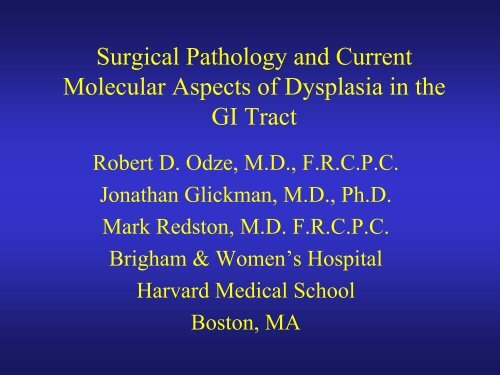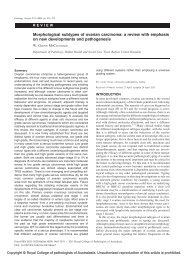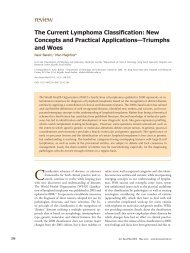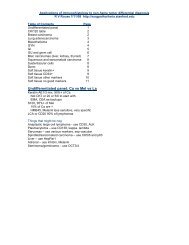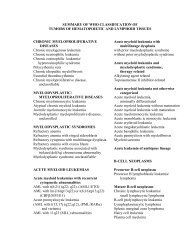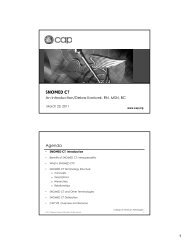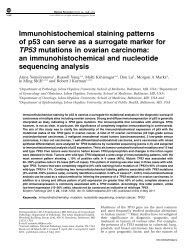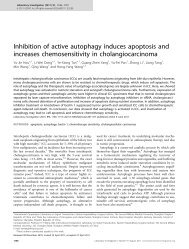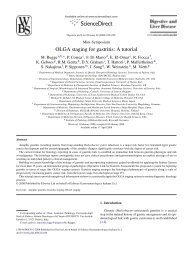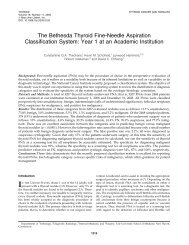Barrett's Esophagus - BPA Pathology
Barrett's Esophagus - BPA Pathology
Barrett's Esophagus - BPA Pathology
- No tags were found...
Create successful ePaper yourself
Turn your PDF publications into a flip-book with our unique Google optimized e-Paper software.
Surgical <strong>Pathology</strong> and CurrentMolecular Aspects of Dysplasia in theGI TractRobert D. Odze, M.D., F.R.C.P.C.Jonathan Glickman, M.D., Ph.D.Mark Redston, M.D. F.R.C.P.C.Brigham & Women’s HospitalHarvard Medical SchoolBoston, MA
Barrett’s <strong>Esophagus</strong>:Metaplasia and Dysplasia1. Metaplasia - Def’n/types- Pathogenesis- Differential Diagnosis2. Dysplasia - Incidence/risk factors- Pathologic Features- Adjunctive Diagnostic tests- Natural History- Treatment
Barrett’s <strong>Esophagus</strong>Definition• Columnar metaplasia ofesophageal squamous epithelium(any length)• Recognized at endoscopy• Goblet cell metaplasia
Barrett’s <strong>Esophagus</strong>Gross Types• Long segment (>3cm)• Short segment (1-3cm)• Ultrashort segment (0-1cm)
Barrett’s <strong>Esophagus</strong>Epithelial Types• Intestinal (“specialized”) type(99%>2cm)• Cardia type (“junctional”)• Fundic type
Barrett’s <strong>Esophagus</strong>:Cell of Origin?• Basal stem cell• Mucosal/submucosalgland/duct stem cell• Gastric epithelium
Multilayered Epithelium
Multilayered Epithelium1. Hybrid epithelium (squam/colum)- EM, cytokeratins2. Biologically active3. Phenotypically similar to Barrett’s<strong>Esophagus</strong>4. Highly associated with Barrett’sesophagus
Short (Ultrashort) BE vs.Chronic Carditis• Distinction Important• Different clinical, etiologic,pathologic, outcome, risk ofmalignancy
Mucin Histochemistry______________________________________________________Stain Esoph CardiaGoblet Non-Goblet Goblet Non-Goblet______________________________________________________Alcian blue + + + +(acid mucinHigh Iron diamine + + + -(sulphomucin)_____________________________________________________
Esophageal versus Cardia__________________________________________Intestinal MetaplasiaFeature <strong>Esophagus</strong> IM Cardia IM(BE)___________________________________________________________1. GERD clinical profile + -2. Irregular Z line + -3. Esophagitis (histologic) + -4. Gastritis (histologic) - +5. H. Pylori - +6. Eosinophils ++ +7. Neut, Plasma, Lymphocytes + ++8. Multilayered epithelium + -9. HID stain positive + -10. MUC 1, 6 positive + -11. BE CK 7/20 pattern + +/-12. Complete > incomplete IM - +__________________________________________________________
Barrett’s <strong>Esophagus</strong>Dysplasia: Definition• “Neoplastic epithelium that remainsconfined within the basement membrane”• not reactive• not synonymous with “atypical”• unlikely to spontaneously regress• Both a marker and a precursor ofadenocarcinoma
Barrett’s Dysplasia/CarcinomaRiskPrevalence : 6-8%Incidence : 0.2 – 3% (1/52 – 1/208patient years)Relative Risk: 30-125x
Incidence Rate of Adenocarcinoma inBarrett’s <strong>Esophagus</strong>__________________________________________________________________Incidence Follow-upSeries Patients Cases (Patient Incidence(No.) (No) Years) Rate__________________________________________________________________Haammeeteman et al 50 5 260 1/52Bonelli et al 71 2 110 1/55Roberston et al 56 4 224 1/56Miros et al 81 3 289 1/96Iftikhar et al 107 4 462 1/115Drewitz et al 170 4 834 1/208O’Connor et al 136 2 570 1/285Sepchler et al 108 4 1037 1/259Sharma et al 618 12 2546 1/212_________________________________________________________________
Barrett’s Dysplasia/CarcinomaRisk FactorsLength of BESeverity of RefluxHiatus Hernia sizeGenderEthnicityAgeSmoking?Alcohol?
Patient Characteristics__________________________________________________________________VariableGERD Barrett’s HGD/CA(N=2170) (N=1189) (N=131)__________________________________________________________________Male sex 98% 99% 99%Age (yr*) 59+13 61+11 63+10White ethnicity 76% 83% 89%Ethanol Consumption 40% 37% 42%Smoking 34% 25% 27%Hiatal hernia 24% 65% 84%Hiatal hernia size (cm*) 0.4+1.1 2.4+1.9 3.5+2.3Barrett’s length (cm*) 2.6+2.1 5.0+4.4__________________________________________________________________Avidan et al. Am J Gastroenterol 2002;97(8) 1930-1936
DysplasiaPathologic Features1. Gross - Flat- Elevated (plaque, nodule, polyp)2. Microscopic - Adenoma-like- Non-adenoma like
Dysplasia in the GI TractNegativeIndefinitePositive (low, high)Intramucosal AdenoCaSubmucosal (Invasive) AdenoCa
Non-Recommended Terms“Atypia”“Adenomatous Changes”“Carcinoma in Situ”
Barrett’s <strong>Esophagus</strong>_________________________Feature Regeneration Dysplasia__________________________________________Inflammation ++ +/-Ulceration ++ +/-Surface Maturation + -Pleomorphism - +/-Loss of Polarity - +/-Atypical Mitoses - +/-Surface Proliferation +/- ++Villiform Change +- +/-Mucin Depletion +/- ++__________________________________________
Barrett’s-related DysplasiaInterobserver Agreement__________________________________________Category% agreement__________________________________________HGD + IMC vs. others 85-87%Negative vs. others 71-72%Negative + Ind vs. others 75-77%Neg vs. Ind/LGD vs. HGD/IMC 58-61%__________________________________________Reid BJ et al. Hum Pathol 1988
Barrett’s-related DysplasiaInterobserver Variation__________________________________________Category Set 1 Set 2__________________________________________No dysplasia 0.44 (mod) 0.58Indefinite 0.13 (slight) 0.15Low grade 0/23 (fair) 0.31High grade/cancer 0.63 (substantial) 0.64__________________________________________Montgomery EA et al. Hum Pathol 2001
Adjunctive TechniquesProliferation MarkersDNA content (aneuploidy)TelomeraseGenetic mutations (p53, p16, Kras, APC,B catenin)Growth FactorsApoptosis InhibitorsCyclooxygenase 2
Natural History_____________________________________Dysplasia (%) n Cancer (%)_____________________________________None 382 9 (2)Low grade 72 5 (7)High grade 170 37 (22)_____________________________________Sampliner. Am J Gastroenterol 2002:97(8);1888-1895
Esophagectomy forHigh-Grade Dysplasia__________________________________________Series Unsuspected Carcinoma__________________________________________Edwards (1996) 8/11 (73%)Heimiller (1996) 13/30 (43%)Cameron (1997) 2/19 (10.5%)Ferguson (1997) 8/15 (53%)Falk (1997) 4/12 (33%)Total 35/87 (40%)_________________________________________
Management• Controversial• Varies between institutions• Dependent on surveillancetechniques
ACG guidelines for Surveillance in Barrett’s esophagus:(Sampliner et al, Am J Gastroenterol 97:1888,2002)Chronic GERD SymptomsScreening Endoscopy with BiopsiesNegative for dysplasia Low grade dysplasia High-grade dysplasiax2 endoscopiesRepeat endoscopy with biopsyExpert pathologist opinion3 year surveillance Repeat x 1Focal Mucosal MultifocalAnnual surveillanceirregularityUntil no dysplasia 3 months Interventionsurveillance EMR (surgical)
Ideal Biopsy Protocol• Jumbo forceps• 4 quadrant Q2 cm in BE• 4 quadrant Q1 cm in dysplasia• All nodules/polyps/masses• Confirm with experienced GIpathologist
Management ConsiderationsSurveillance vs. EsophagectomyExtent of HGDNodularityPatient ageComorbiditiesLength of BE
Barrett’s <strong>Esophagus</strong>:New Surveillance Strategies• Balloon cytology• Fluorescence spectroscopy• Chromoendoscopy• Flow cytometry
Molecular Basis ofBarrett’s <strong>Esophagus</strong>•Stepwise genetic progression•Specific factors•aneuploidy•17p deletion/p53 mutation•p16•cyclin D1
Genetic Progressionin Barrett’s <strong>Esophagus</strong>•11q13 amplification/Cyclin D1overexpression•5q21 deletion/APC inactivation•9p21 deletion/p16 inactivation•13q14 deletion/Rb inactivation•17p13 deletion/p53 mutation•p21 overexpression•p27 loss•aneuploidy•telomerase overexpression•7p12 amplification/EGFRoverexpression•17q21 amplification/HER2overexpression•19q12 amplification/Cyclin Eoverexpression•other amplifications (2p, 8q, 20q)•chromosomal deletions (3p, 4p,7q, 12q, 17q, 22q)•E and P cadherin lossBarrett’s LGD HGD AdenoCa
Non-DysplasticBarrett’s <strong>Esophagus</strong>•11q13 amplification/Cyclin D1overexpression•Bcl2 overexpression•5q21 deletion/APC inactivation•9p21 deletion/p16 inactivation•13q14 deletion/Rb inactivation•17p13 deletion/p53 mutation•aneuploidyNormalBEHigh RiskBEDysplasiaCancer
Aneuploidy•Normal cells:•diploid (2N)•tetraploid (4N; G2 phase)•S phase cells•Gains or losses of entire chromosomes•Peaks of abnormal DNA content•Abnormally large tetraploid peaks
Aneuploidy Predicts Progressionin Barrett’s <strong>Esophagus</strong>Histology Ploidy Dysplasia/CancerProgressionNegativeIndefiniteLGDTotaldiploidaneuploid/4Ndiploidaneuploid/4Ndiploidaneuploid/4Ndiploidaneuploid/4N2/1101/101/721/110/334/113/2156/32Reid et al, Am J Gastroenterol 95:1669;2000
Tumor Suppressor Genes•Cellular “brakes” or checkpoints•“OFF” signal•Inhibit cell growth•Regulate cell division
p53 Gene Detection•17p loss of heterozygosity (LOH)•p53 gene mutation•SSCP•sequencing•p53 gene immunostaining•mutations stabilize expression
p53 Gene Mutations inBarrett’s <strong>Esophagus</strong>•Frequency:•negative 5%•indefinite 5%•LGD 20%•HGD 60%•Mucosa beside positive dysplasia
17p LOH & Progressionin Barrett’s NeoplasiaHistology Alteration Progression Relative RiskNeg/Indef/LGD 17p intact 16/178 (9%)17p LOH 5/19 (26%) RR 3.6HGD 17p intact 5/24 (21%)17p LOH 18/35 (51%) RR 3.0Reid et al, Am J Gastroenterol 96:2839;2001
p53 Immunostain & Progressionin Barrett’s NeoplasiaStudyYounes 1997Bani-Hani 2000Weston 2001p53ImmunostainnegativepositivenegativepositivenegativepositiveProgression FromIndefinite/LGD0/16 (0%)5/9 (55%)7/41 (17%)4/11 (36%)2/25 (8%)3/6 (50%)
p53 “Positive” Immunostaining
p53 “Positive” Immunostaining
p53 Positive Barrett’s Indefinite
p16/INK4a/CDKN2A Gene•Regulation of cell cycle•G1 phase•Binds Cdk4•Competes with Cyclin D1•Inhibits phosphorylation of Rb•Induces growth arrest
Detection of p16 Inactivationin Barrett’s <strong>Esophagus</strong>•9p21 deletion (LOH)•Promoter CpG island methylation•p16 mutation•Loss of p16 immunostaining
p16 Inactivationin Barrett’s <strong>Esophagus</strong>•Common early event•Large non-dysplastic fields•>85% of dysplasias•Precedes aneuploidy/17p LOH•Not characterized as risk factor
Cyclin D1 Gene•Cyclin/CDK complexes•Regulation of cell cycle•G1 phase•Cyclin D1/Cdk4,6•Phosphorylation of Rb•Progression through cell cycle
Cyclin D1 and Progressionin Barrett’s Neoplasia•Bani-Hani JNCI 92:1316;2001•Case-control study•Cyclin D1 positive immunostain•8/12 adenocarcinoma group•14/49 control group•Odds ratio 6.85
Molecular Summary ofBarrett’s <strong>Esophagus</strong>•Non-dysplastic genetic changes•Stratify progression in negative,indefinite, and LGD
Molecular Summary ofBarrett’s <strong>Esophagus</strong>•Useful predictive factors:•aneuploidy/4N fraction•17p deletion/p53 inactivation•Cyclin D1 expression
Molecular Summary ofBarrett’s <strong>Esophagus</strong>•Further validation required•Molecular stratification ofscreening and follow-up•(New Technologies)
Dysplasia in IBD• Dysplasia in Crohn’s Colitis•Dysplasia in Ulcerative ColitisGeneral commentsRisk factorsTreatment/surveillance• DALM’s in Ulcerative Colitis• Non IBD-dysplasia
Dysplasia in Crohn’s Disease• Risk of Colon Cancer Similar to UC• Involved (SI and colon) anduninvolved areas• Dysplasia-carcinoma sequence• Dysplasia morphologically similarto UC• Endoscopic surveillance controversial
Dysplasia in Crohn’s DiseaseDysplasia-Carcinoma Sequence• Dysplasia adjacent to Ca in 40-100%• More common close to tumor• 2-16% of patients without carcinoma
Dysplasia in Crohn’s Disease(Sigel et al, Am J Surg Pathol 23:651,1999)• 30 Cases Crohn’s Adenocarcinoma• 27% SI, 73% colon (all involved)• Dysplasia adjacent to Ca: 87%• Dysplasia distant to Ca: 41%(75% in UC)
Dysplasia in Ulcerative Colitis• Unequivocal neoplastic epithelium• Marker of malignancy risk• Present in 90% (close and distant) ofcarcinomas• Any portion of colon (parallels cancer)- single, multiple, diffuse• Flat or elevated (DALM)
Risk of Neoplasia in UC1. Dysplasia• 5% incidence/10 years• 25% incidence/20 years2. Carcinoma• 3-43% incidence 25-35 years- 5-10% incidence/20 years- 10-20% incidence/30 years• 1-2%/year after 10 years
Dysplasia/Ca in Ulcerative ColitisRisk Factors• Disease duration (> 10 years)• Disease extent• Primary sclerosing cholangitis• Disease severity• Early age of onset?• Family history of colon cancer?• Folate deficiency?
Primary Sclerosing CholangitisRisk of Dysplasia(Marchesa et al, Am J Gastro 1997;92:1285)• 27 pts with UC and PSC• 1185 pts with UC only• all had total proctocolectomy• 60% vs 12% dysplasia• Rt colon dysplasia/carcinoma
Dysplasia in UCGross Features• Flat• Raised (DALM)
UC-Associated DysplasiaInterobserver Variability_______________________________________________Author # Specimens #Pathologist K value_______________________________________________Odze (2001) 38 4 0.4Melville (1990) 207 5 0.2-0.5Dixon (1988) 100 6 (pairs) 0.4_______________________________________________
Risk of Malignancy in UCAdjunctive Methods• Histochemical ……….. mucin, sialosyn TN• Impox ………………... proliferation• Molecular defects ……. P53, Rb, APC, MI,CIN, P27,P16,aneuploidy• Laser fluorescence ……dysplasia
Flat DysplasiaNatural History(Bernstein et al, Lancet 1994;343:71)1. Low grade- Co-existant carcinoma: 9%- Progression to HGD/CA: 30-54%(5 year predictive value )2. High grade- Co-existent carcinoma: 40-67%- Progression to CA: 40-90%(2-5 year predictive value)
ManagementDysplasiaLow gradeHigh gradeUnifocal• Multifocal• SynchronousSurveillance Colectomy Colectomy? Colectomy
Colectomy for Low Grade Dysplasia_______________________________________________AuthorData_______________________________________________Connell 1994LGD to HGD (54%, 5 years)Taylor 1992 LGD in CA colectomy (34%)Bernstein 1994 CA in LGD colectomy (19%)Woolrich 1992 LGD to CA (18%, 6 years)_______________________________________________
DALM1. Adenoma-like- Sporadic (“Adenoma”)- IBD-associated(“Polypoid dysplasia”)2. Non Adenoma-like
DALMAdenoma LikeSessile/Pedunculatedwell circumscribedsmooth surfacevisible bordersnon-ulceratedno stricture or mucosaltetheringNon Adenoma-LikeUsually sessilePoorly circumscribedIrregular surfaceindistinct borderulceration/necrosis+stricture/tethering
Summary of DALM Studies_______________________________________________Author #Patients % DALM % DALMwith cancer_______________________________________________Blackstone (1981) 112 11% 58%Butt (1983) 62 29% 83%Rosenstock (1985) 248 5% 38%Len-Jones (1990) 401 1.5% 83%Bernstein (1994) 1225 3.2% 43%(10 studies)_______________________________________________
Adenoma vs Polypoid Dysplasia1. Morphology2. Immunohistochemistry3. Molecular defects
Polypoid Dysplasia andAdenomas in InflammatoryBowl DiseaseTorres, Antonioli, OdzeAm J Surg Pathol 1998;22(3):275-284
Adenoma vs Polypoid DysplasiaValue of Impox•Adenoma: β catenin, Bcl-2• Polypoid Dysplasia: P53• Non sensitive and non-specific
IBD vs Sporadic Neoplasia_______________________________________________IBDSporadicGENE Neoplasia Neoplasia________________________________________________________Krasearly, frequent early, frequentP53 (17P) early, (44%) late (20%)LOH 17P early, (85%) Late (20-30%)LOH 9P (P16) early, (50%) RareLOH 3P (50%) early, (50%) Rare, lateAPC (5q) late (6%) early (75%)P27 early, (90%) late (30%)________________________________________________________
Genetic Alterations inChronic ulcerative colitisassociatedadenoma likeDALMS are similar tonon-colitic sporadicadenomasOdze et al, am J Surg Pathol 2000;24(9
Adenoma-like DALMS in UlcerativeColitis_____________________________________________________________CUC Adenoma CUC-like DALM non-adenomaMolecular Non-CUC within outside like DALMMarker Adenoma Colitis Colitis (LOH)n = 23 n = 10 n = 11 n= 12_____________________________________________________________3P 5% 30% 25% 50%* 1APC 33% 29% 38% 43%P16 4% 0% 10% 56%* 2_____________________________________________________________* 1 P=0.01 * 2 P = 0.003
Is it possible to reliablydifferentiate adenoma frompolypoid dysplasia bymorphology, impox, or molecularmethods?No.
Polypectomy may be adequatetreatment for adenoma-likedysplastic lesions in chroniculcerative colitisEngelsqjerd, Farraye, Odze(Gastroenterology 1999;117:1288-1294)
______Feature CUC patients Non-CUCAdenoma-like AdenomaAdenomaDALM________________________________________________________________________# patients 24 1049Follow-up (mths) 42 4137Flat dysplasia 1 (4%) 0 (0%)NANew polyps 58% 50%39%Adenocarcinoma 0% 0%
Colonoscopic polypectomy inchronic colitis: Conservativemanagement after endoscopicresection of dysplastic polypsRubin, Friedman, Harpaz, et al(Gastroenterology 1999;117:1295-1300)
Rubin et al________________________________________No further polyps 25 (52%)Polyps in same vicinity 13 (27%)Polyps in different location 10 (21%)Dysplasia/CA in flat mucosa 0 (0%)________________________________________
ConclusionIf it looks like anadenomaIt probably is!
DALMAdenoma-likeNon-Adenoma-like(broad-base, irregular)Outside colitisInside colitis• Polypectomy •Polypectomy Colectomy•Regular surveillance •Confirm absenceof flat dysplasia•? Increasesurveillance
Molecular Basis ofColitis-Associated Neoplasia•Stepwise genetic progression•Sporadic vs colitis-associated•Specific factors•aneuploidy•17p deletion/p53 mutation•p16•Genomic instability pathways
Genetic Progression inColitis-Associated Neoplasia•5q21 deletion/APC inactivation•17p13 deletion/p53 mutation•9p21 deletion/p16 inactivation•aneuploidy•13q14 deletion/Rb inactivation•other chromosomal deletions•Kras mutation•p21 overexpression•telomere erosion•18q LOH•p27 down-regulation•other chromosomaldeletions(not well characterized)Normal LGD HGD AdenoCa
Genetic Progression inColitis-Associated Neoplasia•aneuploidy•17p13 deletion/p53 mutation•9p21 deletion/p16 inactivation•chromosomal instabilityNormalNegative/IndefiniteHigh RiskDysplasia/Cancer
Colitis-AssociatedVersus Sporadic Neoplasia•Aneuploidy pre-invasion•p53 mutation pre-invasion•Chromosome 3p deletion•Loss of p27 expression•Less bcl-2 expression•Less beta-catenin staining
Aneuploidy inColitis-Associated Neoplasia•Extremely common•Extensively studied•70-90% of dysplasia/cancers•10-20% of non-dysplastic
Aneuploidy Associations inColitis-Associated Neoplasia•Associated with:•duration•extent•severity•dysplasia•other genetic alterations
neuploidy Predicts Progressionin Colitis-Associated NeoplasiaHistology Ploidy Dysplasia/CancerProgressionNegative diploid 0/15aneuploid 1/1Indefinite diploid 1/5aneuploid 4/4Rubin et al, Gastroenterology 103:1611;1992
neuploidy Predicts Progressionin Non-Dysplastic ColitisStudy Ploidy Dysplasia/CancerProgressionLindberg 1999 diploid 0/127aneuploid 4/10Holzman 2001 diploid 1/39aneuploid 5/10
17p LOH inColitis-Associated Neoplasia________________________________________________LesionFrequency________________________________________________Carcinoma 22/26(85%)HGD 25/40(63%)
p53 inNegative/IndefiniteMucosa
p53 Mutation PredictsProgression in Colitis Neoplasia•Holzmann Scand J Gastroenterol 2001•83 high risk UC patients•p53 mutations predict progression:•no mutation - 3/64 (5%)•yes mutation - 7/18 (39%)•Less predictive than aneuploidy
Other Markers inColitis-Associated Neoplasia•Proliferation index (Ki67)•Cyclin A•E-cadherin•Sialosyl-Tn antigen•Metallothionein•Further studies needed to validate
Chromosomal Instability by FISHCentromere probeChromosome arm probeNormalArmDeletionArm Chromosome ChromosomeAmplification Gain Loss
Chromosomal Instability (CIN)in Colitis-Associated Neoplasia•Dual color FISH chromosomes 8, 11, 17, 18•Histologically negative rectal biopsies•CIN present in:•10% non-IBD control cells•22% negative colitis cells (dysplasia orcancer elsewhere)•P
Telomere Erosion inColitis-Associated Neoplasia•“Cap” on ends of chromosomes•Maintain genome stability•Loss associated with senescence•Accelerated shortening with:•rapid cell turnover•oxidative injury
Telomere Erosion inColitis-Associated Neoplasia•O’Sullivan et al, Nature Genetics 2002•Determined telomere length innon-dysplastic mucosa by FISH•Patients with and without HGD/cancer•Telomere erosion associated with:•chromosomal instability•progression to HGD/cancer)
Fecal DNA Mutation Testing•Cells shed into lumen•Target DNA by hybridcapture•Test specific mutationpanel•Kras•p53•APC•DNA integrity
Fecal DNA Mutation Testing•High sensitivity/specificity inCRC•Adenoma validation ongoing•Testing required on colitis•Development of costeffectivekit
Molecular Summary ofColitis-Associated Neoplasia•Useful predictive factors:•Aneuploidy•17p deletion/p53 inactivation•Chromosomal instability•Telomere erosion
Squamous Dysplasia
Esophageal squamous dysplasia• General comments• Clinical features• Pathologic features• Differential diagnosis• Natural history, treatment
Squamous dysplasiaclinical features• Similar risk factors as squamous cellcarcinoma (tobacco, alcohol, nutritionalfactors, hot beverages, chronic esophagitis,?HPV)• More common in high incidence areas ofsquamous cell carcinoma• Dysplasia frequently (up to 60%) adjacentto invasive carcinoma
Esophageal squamous dysplasiaClassificationCurrent/WHO• NegativePrevious• Negative• Low grade• Mild• Moderate• High grade• Severe• “Carcinoma in situ”
Pathologic features• Gross: erythematous, irregular, friable;erosions, plaques, nodules; may be normal• Location: mid-distal esophagus (similar toSCC)• Lugol’s iodine• Baloon cytology in high risk areas
Squamous dysplasia- differentialdiagnosis• Reactive squamous epithelium• Giant cell esophagitis• Chemoradiotherapy effect• Invasive squamous cell carcinoma
Squamous dysplasia vs reactiveFeature Reactive DysplasticNuclearpleomorphism- +Hyperchromasia -/+ +Crowding - +Increased N/C -/+ ++Increased mitoses -/+ +Surface maturation + -/+
Squamous dysplasiaNatural historyDiagnosisProgressIntervalRR ofcarcinomaLow grade15%8-15 yrs2-16High grade30%8 yrs60-70•Increased risk for developing carcinoma•Must exclude adjacent carcinoma
Squamous dysplasia- treatmentDYSPLASIAFLATELEVATEDLOWGRADEHIGHGRADEPROBABLECARCINOMAFOLLOWREBIOPSYRESECTION
Molecular Basis of SquamousDysplasia of <strong>Esophagus</strong>•Stepwise genetic progression•Specific factors•p53 mutation
Genetic Progression inEsophageal Squamous Neoplasia•17p13 deletion/p53 mutation•7p12 amplification/EGFRoverexpression•8q24.1 amplification/c-mycoverexpression•11q13 amplification/cyclin D1overexpression•9p21 deletion/p16 inactivavtion•chromosomal deletions (1p, 3p,5q, 11q, 18q)NormalSquamousDysplasiaSquamousCarcinoma
P53 immunostainNormalDysplasia
p53 Immunostaining inEsophageal Squamous Neoplasia•Fagundes Dis <strong>Esophagus</strong> 2001ConditionNormalMild esophagitisModerate esophagitisSevere esophagitisLGDHGDp53 positivity12/103 (12%)6/43 (14%)4/18 (22%)1/3 (33%)4/11 (36%)2/2 (100%)
Molecular Summary ofEsophageal Squamous Neoplasia•Predictive markers possible•p53 immunostaining•Many further studies required•(New Technologies)
Small Intestinal Metaplasia andDysplasia
Small intestinemetaplasia and heterotopia• Gastric mucous cell metaplasia• Pyloric gland metaplasia• Gastric heterotopia• Pancreatic heterotopia
Mucous cell metaplasia• Feature of chronic duodenitis secondary topeptic injury• Association with H. pylori gastritis• Proximal duodenum or bulb• Ddx: gastric heterotopia
Pyloric gland metaplasia• Marker of chronic mucosal injury in smallintestine (e.g. Crohn’s disease)• Up to 22% of Crohn’s patients• Most common in ileum• Usually incidental finding• May form visible mucosal nodule
Small intestinal dysplasia• Crohn’s disease-associated dysplasia• Sporadic adenomas• Polyposis-associated dysplasia–FAP– Peutz-Jegher’s syndrome– Other polyposis syndromes
Crohn’s disease-associateddysplasia• 5% lifetime risk of carcinoma• median disease duration 15 years• Most (70%) are in colon, rectum• 20-100X risk of small intestinaladenocarcinoma• Dysplasia-carcinoma sequence appearssimilar to colon
Gastric Metaplasia and Dysplasia
Intestinal-type gastric carcinomaamultistep processNormalChronic (active) gastritisChronic atrophic gastritisIntestinal metaplasiaDysplasiaCarcinoma
Gastric carcinoma- risk factors• H. pylori gastritis• Autoimmne gastritis/pernicious anemia• Post-gastrectomy• Gastric polyps• Diet, environmental factors• (Cardia tumors: ?reflux)
Types of gastric epithelial• Intestinalmetaplasia• Pseudopyloric• Ciliated• (Pancreatic: actually a heterotopia?)
Intestinal metaplasiaclassificationIM TypeGoblet cellsMucinouscolumnarcellsOther celltypes(Paneth,endocrine)Cancer risk?Complete(Type I)Sialomucin+Sulfomucin+Not present Present NoIncomplete(Type II)Sialomucin+Sulfomucin+Sialomucin+Sulfomucin-+/- Yes?Incomplete(Type III)Sialomucin+Sulfomucin+Sialomucin+Sulfomucin++/- Yes?
Gastric dysplasia- issues• Different grading systems• Regeneration vs true dysplasia• Significance of “mild dysplasia”• High grade dysplasia vs adenocarcinoma
Gastric dysplasiaPadova classification• Negative for dysplasia– Normal– Reactive foveolar hyperplasia– Intestinal metaplasia (IM)• Indefinite for dysplasia– Foveolar hyperproliferation– Hyperproliferative IM• Non-invasive neoplasia– low-grade dysplasia– high grade dysplasia• Suspicious for invasive carcinoma• Invasive carcinoma
Gastric dysplasiaJapanese classificationCATEGORY DEFINITIONHISTOLOGIC EQUIVALENTGroup IGroup IIGroup IIIGroup IVGroup VNormal/no atypiaAtypia butdiagnosedas benignBorderline betweenbenign & malignantStrongly suspectedof carcinomaCarcinomaNormal, regenerative,hyperplastic, intestinal metaplasiaRegenerative with atypia (us.Architectural) due toinflammationDysplasia (flat and adenoma)?low grade ?high gradeHigh grade dysplasia?Invasive carcinoma.High grade dysplasia?Adapted from Rugge M AJSP 24:167 (2000)
Gastric dysplasia-differentialdiagnosis• Reactive epithelium adjacent to ulcer• Reactive (chemical) gastropathy• Treatment effect• Invasive carcinoma
Gastric dysplasia- natural historyStartingDxNRegressPersistProgressto CAMediantime(mos)Indefinite989%11%0%---Low grade9053%38%9%48High grade166%25%69%30Suspicious30%67%33%30Rugge et al Gut 52:1111 (2003)
Gastric DysplasiaManagementLOW GRADEHIGH GRADENO MASSMASSSURVEILLANCEREBIOPSY,CLOSEFOLLOWUPREBIOPSY,CONSIDERRESECTION
Gastric polypsNon-neoplasticDysplasia?• Hyperplasticrare• Fundic gland polyp• Sporadic -• FAP-associated +• Other polyposisrare(juvenile, Cowden’s)Neoplastic• Adenoma ++
Gastric hyperplastic polyps• Most common gastric polyp• Prevalence 0.1%• More common a/w gastritis• Gross: antrum>fundus, cardia; avergae 1.0cm
Dysplasia in hyperplastic polyps• Intestinal metaplasia in 15-25%• Dysplasia in 2-19%• Carcinoma in 0-17% (average 2%)• Dysplasia more common in larger (>2 cm)pedunculated polyps with intestinalizedepithelium
Fundic gland polypsClinical features• Hamartomatous polyp• Sporadic: 0.1-1% prevalence, F>M, middleaged, 40% multiple• Association with PPI therapy• FAP: present in 50-100% of patients, >90%multiple
Dysplasia in fundic gland polyps• Sporadic:
Molecular Basis ofGastric Dysplasia•Stepwise genetic progression•Specific factors•p53•MLH1•APC•Fundic gland polyps
Genetic Progressionin Gastric Neoplasia•5q21 deletion/APC inactivation•17p13 deletion/p53 mutation•MLH1 methylation•C-met/HGF amplification/overexpression•9p21 deletion/p16 inactivation•19q12 amplification/Cyclin Eoverexpression•18q deletion•16q22 deletion/E-cadherin loss•chromosomal deletions (1p, 1q,7q, 13q)Normal Metaplasia Dysplasia AdenoCa
p53 Alterations in GastricMetaplasia and Dysplasia•Shiao Am J Pathol 1994•12 resections•p53 immunostaining/mutations•metaplasia 38%•dysplasia 58%•carcinoma 67%
Microsatellite Instability inGastric Adenocarcinoma•Mismatch repair gene defect•Microsatellite instability•Present in 15-25% gastric Ca•Rarely germline (HNPCC)•Most caused by:•MLH1 methylation•Loss of MLH1 expression
MSH2MSH3DNA mismatchmismatch bindingMLH1MSH2 MSH3PMS1recruit partnersconformation changeMLH1PMS1MSH2 MSH3Modified from Fishel et alCancer Research 61:7369;2001
Analysis of DNA MismatchRepair From TumoursImmunohistochemistry 6 X 6 micronH&E X1Review and mark slidefor dissectionUnstained 10 X 10 micronBrighamandWomen’sNTBrighamandWomen’sOverlay on H&E and scrape tissue from unstainedExtract DNA for MSI testing
Mismatch Repair Gene ImmunohistochemistryMLH1MSH2MLH1MSH2
Microsatellite Instability inGastric Metaplasia/Dysplasia•Leung Am J Pathol 2000•MSI in 7/75 (9%) intestinalmetaplasia•Associated with MSI cancers
MLH1 Methylation inGastric Metaplasia/Dysplasia•Kang Canc Res 2001•MLH1 methylation in:•chronic gastritis 0%•intestinal metaplasia 6%•adenoma 10%•carcinoma 20%
CpG Island Methylation inGastric Metaplasia/Dysplasia•Kang Canc Res 2001•p16, THBS1, TIMP3•CpG island methylation in:•chronic gastritis 0-15%•intestinal metaplasia 2-36%•adenoma 11-27%•carcinoma 42-57%
Fundic Gland Polyps•Occur in two settings•Familial Adenomatous Polyposis•Occasionally have epithelial dysplasia•Sporadic•Rarely have dysplasia
APC inWNTSignalingAXINAPCWNTFrizzledDvlGSK3ßß-cateninPß-cateninß-cateninLEF1C-Mycand others
Genetic Predictors of Dysplasiain Fundic Gland Polyps•APC mutation associated with dysplasia•FAP-associated FGPs•rare sporadic FGPs•Beta-catenin mutation not dysplastic•most sporadic FGPs
Molecular Summary ofGastric Dysplasia•Predictive markers possible•Promising markers:•p53 immunostaining•MLH1/other gene methylation•Many further studies required•(New Technologies)


